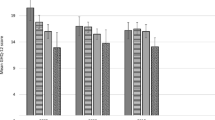Abstract
Context
Psychotherapies are recommended in manuals of good practice. There is however little epidemiological data assessing access to this type of treatment, and in particular the combined role of the offer and socio-demographic characteristics. The present research aims to contribute data on the profiles of a sample of individuals who underwent psychotherapy in France, and on the respective impact of various factors such as mental health status, socio-demographic characteristics, life events and the care offer, focusing on a specific population for whom the mode of financial cover for this type of care is governed by a complementary health insurance (MGEN).
Methods
etween June 1999 and March 2000 a survey using a self-administered questionnaire was conducted on a sample of MGEN-insured individuals. Ten thousand individuals aged between 20 and 60 were selected randomly, received a questionnaire, and up to three recalls in case of non-response. The overall response rate was 66.5%. The questionnaire comprised 261 questions enabling data collection concerning the main socio-demographic, professional and mental health variables.
Results
In this population aged from 20 to 60, lifetime prevalence of recourse to psychotherapy was 11.8%. The main factor associated with use of psychotherapy is the severity of the clinical condition (assessed in terms of comorbidity). Certain traumatic events experienced in childhood are also related. The effect of socio-demographic variables varies according to severity, although it was noted that being female, having high educational status, and being single were consistently related to wider use of psychotherapy. The analysis also evidenced the importance of the density of the care offer.
Conclusion
Our results suggest that the use of psychotherapy, within a well-informed population with high quality insurance cover, is related primarily to clinical condition rather than to socio-demographic status, especially in people with high levels of comorbidity, although the effect of educational status remains. However, this study only looked at mere use of psychotherapy, without determining the suitability of the treatment provided. It is indeed possible, and even probable, that variables such as educational status, income, or care offer may have a link with resorting to the right type of care, in terms of both relevance and adequate duration.
Similar content being viewed by others
Notes
MGEN is a professional-based health insurance (school and university teachers and their relatives: 60% are in teaching). It has nationwide coverage, with around three million people (mainly women, between 40 and 60 years). The basic coverage (SS) plus complementary cover for 95% of members provides a comprehensive insurance system (drugs, medical care, and hospitalization).
References
American Psychiatric Association (1994) Diagnostic and statistical manual of mental disorders. APA, Washington DC
Andrews G, Henderson S, Hall W (2001) Prevalence, comorbidity, disability and service utilisation. Overview of the Australian National Mental Health Survey. Br J Psychiatry 178:145–153
APA (2000) Practice guideline for the treatment of patients with major depressive disorder (revision). American Psychiatric Association. Am J Psychiatry 157:1–45
Brugha T, Bebington P, Tennant C, Hurry J (1985) The list of threatening experiences: A subset of 12 life events categories with considerable long-term contextual threat. Psychol med 15:189–194
Brugha TS, Cragg D (1990) The list of threatening experiences: the reliability and validity of a brief life events questionnaire. Acta Psychiatr Scand 82:77–81
Champion F (2005) Les psychothérapeutes en recherche de reconnaissance professionnelle. La difficile construction d’une légitimité, Rapport Mire, juin
de Graaf R, Bijl RV, Smit F, Ravelli A, Vollebergh WA (2000) Psychiatric and sociodemographic predictors of attrition in a longitudinal study: The Netherlands Mental Health Survey and Incidence Study (NEMESIS). Am J Epidemiol 152(11):1039–1047
Fansten M (2004) «la demande d’extraterritorialité de la psychanalyse française: fondements, problèmes, enjeux», thèse de doctorat de sciences sociales (sociologie), Université Paris V, 8 décembre 2004
HAS (2002) Prise en charge d’un épisode dépressif isolé de l’adulte en ambulatoire. in Recommandations Pour La Pratique Clinique, edited by Service des recommandations et références professionnelles, Paris
Kessler RC, Chiu WT, Demler O, Merikangas KR, Walters EE (2005) Prevalence, severity, and comorbidity of 12-month DSM-IV disorders in the National Comorbidity Survey Replication. Arch Gen Psychiatry 62:617–627
Kovess V, et al (2007) Differences in lifetime use of services for mental health problems in six European countries, Psychiatr Serv 58(2):213–220
Lafitte C, Martin C, Grabot D, et al (1996) A survey of private practice psychiatrist’s training and activity in Aquitaine, France, in 1993. Encephale 22:417–421
Lutz W, Lowry J, Kopta SM, Eisensten DA, Howard KI (2001) Prediction of dose-response relations based on patient characteristics. J Clin Psychol 57:889–900
NICE, National Institute for Clinical Excellence (2004) Depression: management of depression in primary and secondary care, Clinical Guideline N° CG 23, December 2004, London
Olfson M, Marcus SC, Druss B, Pincus HA (2002) National trends in the use of outpatient psychotherapy. Am J Psychiatry 159(11):1914–1920
Olfson M, Pincus HA (1994) Outpatient psychotherapy in the United States, I: volume, costs, and user characteristics. Am J Psychiatry 151(9):1281–1288
Reesal RT, Lam RW (2001) Clinical guidelines for the treatment of depressive disorders. II. Principles of management. Can J Psychiatry 1 (46 Suppl):21S–28S
Roth A, Fonagy P (2005) What works for whom: a critical review of psychotherapy research. Guilford, New York
Sicart D (2006) Les médecins, Estimations au 1er janvier 2006, DREES, séries statistiques, No 103, Octobre
Verdoux H, Tignol J (2003) « Focus on psychiatry in France ». Br J Psychiatry 183:466–471
Wang J, Patten SB, et al (2005) Help-seeking behaviours of individuals with mood disorders. Can J Psychiatry 50(10):652–659
Author information
Authors and Affiliations
Corresponding author
Rights and permissions
About this article
Cite this article
Briffault, X., Sapinho, D., Villamaux, M. et al. Factors associated with use of psychotherapy. Soc Psychiat Epidemiol 43, 165–171 (2008). https://doi.org/10.1007/s00127-007-0281-1
Received:
Accepted:
Published:
Issue Date:
DOI: https://doi.org/10.1007/s00127-007-0281-1




